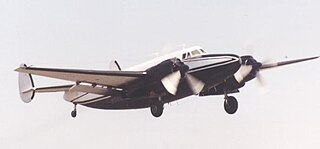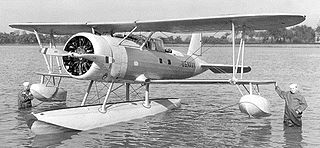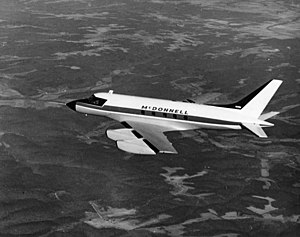
The McDonnell XF-88 Voodoo was a long-range, twinjet fighter aircraft with swept wings designed for the United States Air Force. Although it never entered production, its design was adapted for the subsequent supersonic F-101 Voodoo.

The North American T-2 Buckeye was the United States Navy's intermediate training aircraft, intended to introduce U.S. Navy and U.S. Marine Corps student naval aviators and student naval flight officers to jets. It entered service in 1959, beginning the replacement process of the Lockheed T2V SeaStar, and was itself replaced by the McDonnell Douglas T-45 Goshawk in 2008.

The Douglas Y1B-7 was a 1930s American bomber aircraft. It was the first US monoplane given the B- 'bomber' designation. The monoplane was more practical and less expensive than the biplane, and the United States Army Air Corps chose to experiment with monoplanes for this reason. At the time the XB-7 was ordered, it was being tested by Douglas Aircraft as an observational plane.

The Douglas A2D Skyshark was an American turboprop-powered attack aircraft built by the Douglas Aircraft Company for the United States Navy. The program was substantially delayed by engine reliability problems, and was canceled because more promising jet attack aircraft had entered development and the smaller escort carriers the A2D was intended to utilize were being phased out.
The Douglas XB-31 was the design submitted by Douglas after the request by the United States Army Air Forces for a very heavy bomber aircraft, the same request that led to the Boeing B-29 Superfortress, Lockheed XB-30, and Consolidated B-32 Dominator.

The Lockheed XV-4 Hummingbird was a U.S. Army project to demonstrate the feasibility of using VTOL for a surveillance aircraft carrying target-acquisition and sensory equipment. It was designed and built by the Lockheed Corporation in the 1960s, one of many attempts to produce a V/STOL vertical take off/landing jet. Both prototype aircraft were destroyed in accidents.

The Douglas C-1 was a cargo/transport aircraft produced by the Douglas Aircraft Corporation for the United States Army Air Service starting in 1925.

The Douglas T2D was an American twin-engined torpedo bomber contracted by the military, and required to be usable on wheels or floats, and operating from aircraft carriers. It was the first twin-engined aircraft to be operated from an aircraft carrier.

The Douglas O-43 was a monoplane observation aircraft used by the United States Army Air Corps.

The Breguet 941 was a French four-engine turboprop short takeoff and landing (STOL) transport aircraft developed by Breguet in the 1960s. Although widely promoted, both by Breguet in France and by McDonnell Aircraft and McDonnell Douglas in the United States, it was not built in large numbers; only one prototype and four production aircraft were built.

The Howard 500 is an American executive transport aircraft produced by Howard Aero Incorporated during the early 1960s.

The Douglas XP3D was a prototype American patrol flying boat of the 1930s. A twin-engined high-winged monoplane, the P3D was produced by the Douglas Aircraft Company to equip the US Navy's Patrol squadrons, but despite meeting the Navy's requirements, the rival Consolidated PBY was preferred owing to a lower price.

The Lockheed Model 34 Big Dipper was an American two-seat monoplane, designed and built by Lockheed at Burbank for research into the company's potential entry into the civil lightplane and military light utility aircraft market. Only one was built, and following its loss in an accident the program was abandoned.

The Douglas XO2D-1 was a prototype American observation floatplane of the 1930s. It was a single engined biplane intended to be launched by aircraft catapult from ships of the United States Navy, but only one was built, the production contract going to Curtiss for the SOC Seagull.

The Lockheed Model 33 Little Dipper, also known as Air Trooper, was an American single-seat monoplane, designed by John Thorp and built by Lockheed at Burbank, California. Flown in 1944 and offered to the Army as a "flying motorcycle", it was evaluated as a potential entry for Lockheed into the civilian market, but the program was cancelled before the second prototype was completed.

The Douglas Cloudster II was an American prototype five-seat light aircraft of the late 1940s. It was of unusual layout, with two buried piston engines driving a single pusher propeller. Only a single example was built, which flew only twice, as it proved too expensive to be commercially viable.
The Nakajima D3N was a Japanese carrier-based dive bomber of the 1930s. Three prototypes were built for the Imperial Japanese Navy, but no production followed, with the Aichi D3A being selected instead.
The Lockheed Aequare was an unmanned aerial vehicle developed by the Lockheed Missiles and Space Company for the United States Air Force. It was intended for launch from an F-4 Phantom II fighter-bomber, and would carry a remote sensor array and laser designator for use by the launching aircraft. The system was evaluated in the mid 1970s, but did not enter operational service.
The McDonnell XHCH was a 1950s aerial crane helicopter proposal for the United States Navy by the McDonnell Corporation.
The McDonnell 120 Flying Crane, also V-1 Jeep, was a lightweight utility flying crane helicopter designed and built by the McDonnell Aircraft Corporation during the 1950s. The open frame fuselage supported the three gas-producers and main rotor mast, with a small single-seat cockpit in the nose, which was originally open, but later enclosed.
















